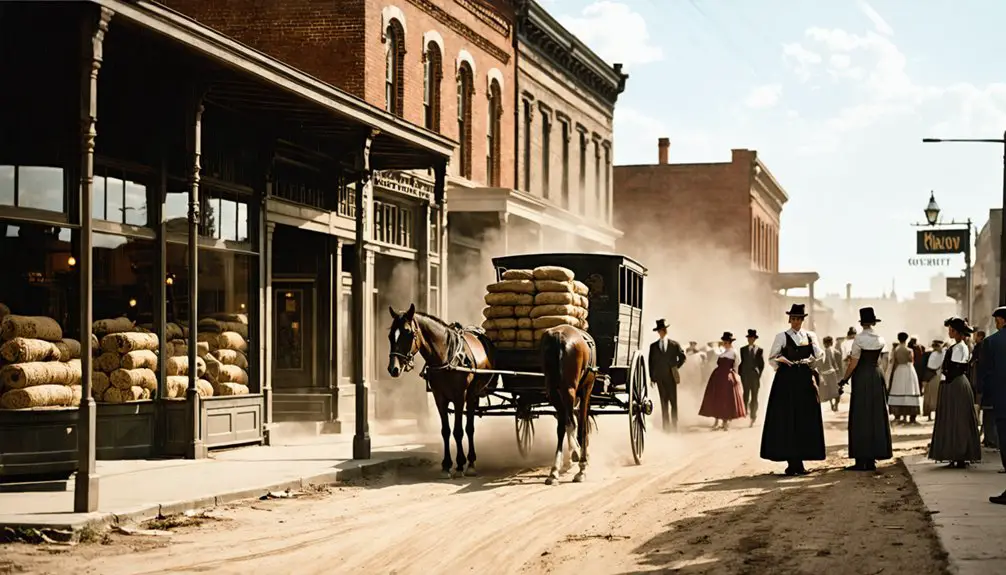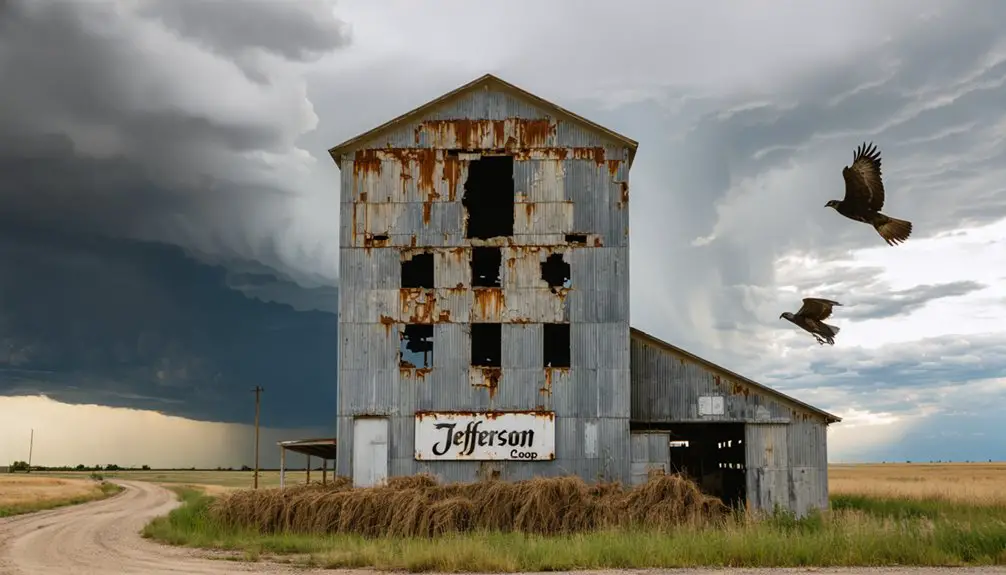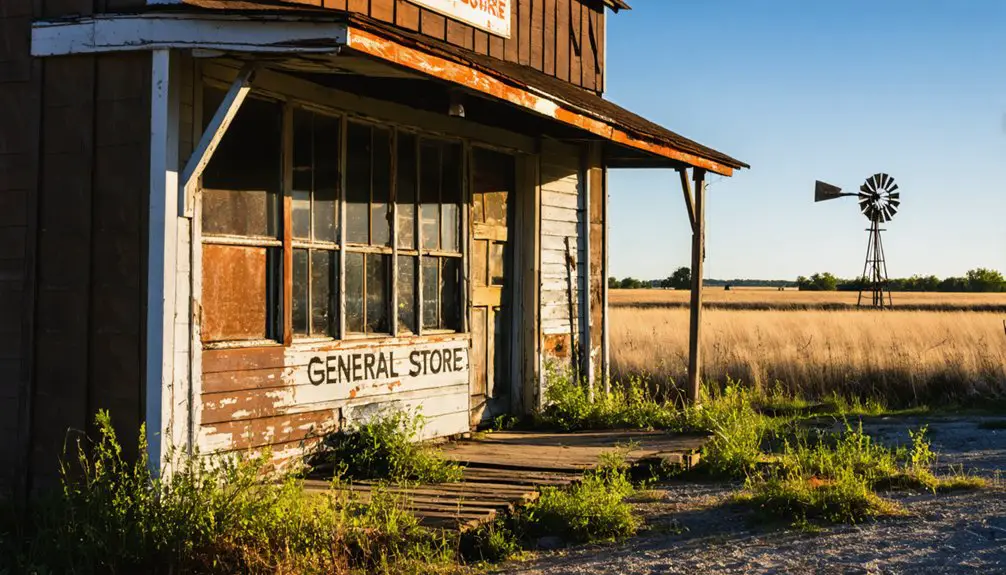You’ll find Jefferson, Oklahoma’s fascinating ghost town legacy in its railroad roots, established in 1888 as Pond Creek before being renamed in 1896. The town flourished as an agricultural hub along the Chicago, Rock Island and Pacific Railway, with grain elevators, banks, and churches serving a tight-knit pioneer community. Though the devastating flood of 1944 and changing transportation routes led to its decline, Jefferson’s scattered ruins tell compelling stories of frontier life and resilience.
Key Takeaways
- Jefferson, Oklahoma began as a thriving railway town in 1888, initially named Pond Creek before its renaming in 1896.
- The town flourished as an agricultural center with grain elevators, banks, and livestock facilities along the Chicago, Rock Island railway.
- A devastating flood in 1944 severely damaged homes and businesses, marking the beginning of Jefferson’s decline.
- The loss of the post office and being bypassed by major transportation routes led to Jefferson’s eventual abandonment.
- Today, Jefferson exists as a ghost town with abandoned structures and ruins, though preservation efforts continue to protect its history.
The Birth of a Railroad Town
As the Chicago, Kansas and Nebraska Railway pushed southward from Caldwell, Kansas in 1888, a strategic location along the historic Chisholm Trail would soon become the town of Jefferson, Oklahoma.
Initially named Pond Creek, this spot caught the railroad’s attention for its abundant water supply and prime position for a station stop.
A natural oasis along the rail line, Pond Creek offered both vital water resources and an ideal railway station location.
You’ll find the town’s origins deeply rooted in the 1893 land run of the Cherokee Outlet, when the federal government opened former Native American territory to settlers.
The railroad’s presence made this site particularly attractive, drawing enthusiastic pioneers who’d build their homes and businesses near the tracks.
To avoid confusion with another Pond Creek just three miles south, the growing community adopted the name Jefferson in 1896, establishing itself as a crucial agricultural trade center along the expanding rail line.
The Chicago, Rock Island railway later took control of these tracks in the early 1900s, continuing the town’s rail legacy.
The town soon prospered with local banks and churches emerging by 1909, marking its transformation into a thriving community.
Early Settlement and Pioneer Life
Before the railroad’s arrival transformed Jefferson into a bustling trade center, hardy pioneers had already recognized the area’s potential. You’d find the earliest settlers clustering around Osage and Pond creeks, where Sewell’s stockade offered protection from American Indian raids in the 1870s.
The Cherokee Outlet opening in 1893 brought waves of determined homesteaders who faced pioneer challenges head-on. Their community resilience shone through as they established essential services – blacksmiths, hardware stores, and grain elevators sprang up to serve local farmers. Like many early ghost towns, Jefferson initially thrived by serving alcohol to residents from neighboring dry territories. Similar to other Oklahoma pioneers detailed in Jim M. Dyer’s book, these settlers endured significant hardships while building their community.
You’ll appreciate how these settlers prioritized education, voting to build their first wooden schoolhouse, and later upgrading to brick in 1918. They also fostered spiritual growth, establishing Methodist and Presbyterian churches.
The Taylor Hotel and Jefferson Stone Company marked the town’s growing prosperity as pioneers transformed raw prairie into an organized community.
Agricultural Legacy and Economic Growth
You’ll find Jefferson’s legacy deeply rooted in its role as a bustling agricultural trade center, which flourished after the Chicago, Kansas and Nebraska Railway established operations in 1889-90.
The town’s strategic position along the railway transformed it into a crucial hub where grain elevators, feed mills, and livestock trading facilities supported the region’s extensive farming operations. Today, only twelve residents remain in what is now considered a ghost town.
Local businesses like blacksmiths, hardware stores, and harness shops sprang up to serve the farming community, creating a self-sustaining economic ecosystem that defined Jefferson’s early prosperity. Similar to nearby communities like Sugden, the town’s economic success relied heavily on shipping cattle and wheat via railroad connections.
Farming Trade Center Growth
During the late 19th and early 20th centuries, Jefferson emerged as a thriving agricultural trade center, fueled by the region’s diverse crop production and strategic location along the railroad.
You’d find essential agricultural services clustered around the town’s core, from blacksmiths and harness shops to grain elevators and feed mills.
The town’s remarkable crop diversity and economic sustainability were supported by specialized services like horse trading, poultry breeding, and wheelwright operations.
By 1909, multiple banks had established themselves to serve the growing farming community, while local institutions like churches and schools flourished.
As farmers reinvested their agricultural wealth, Jefferson’s infrastructure expanded through community-funded projects like school buildings, reflecting the prosperity of this bustling trade hub.
Similar to Thomas Jefferson’s innovative seven-year crop rotation system at Shadwell, local farmers implemented sustainable agricultural practices to maintain soil fertility.
The town’s success paralleled Oklahoma’s broader agricultural boom, as the number of farms in the territory grew from 8,826 farms in 1890.
Railroad Transport Hub Impact
The 1889-90 arrival of the Chicago, Kansas and Nebraska Railway transformed Jefferson into a dynamic transport hub that would shape the town’s destiny.
You’d have seen rail expansion bring dramatic changes as new grain elevators, feed mills, and agricultural services sprang up along the tracks.
The freight efficiency of the railroad network opened distant markets for your crops and livestock, while specialized businesses like blacksmiths and harness shops flourished nearby.
The region’s economic vitality was further enhanced when the Jefferson Highway Association established routes through Oklahoma communities in 1915.
Early Business Development Patterns
Situated amid Oklahoma’s richest farmland, Jefferson quickly blossomed into a thriving agricultural trade center after its founding. Within just a decade, you’d find about twenty stores and shops anchoring the town’s early commerce, supported by two banks that helped fuel local enterprise.
The town’s business diversification reflected its deep agricultural roots. Three grain elevators and a feed mill served local farmers, while specialized services like horse dealers, blacksmiths, and agricultural implement dealers helped modernize farming operations. Medical care was provided by three medical doctors who supported the growing community.
You could find everything from concrete block manufacturing to poultry breeding operations, showcasing the town’s entrepreneurial spirit. Local produce houses connected farmers to broader markets, while weekly newspapers promoted Jefferson’s agricultural opportunities to the region, cementing its position as an essential trade hub.
Daily Life in Jefferson’s Golden Age

Life in Jefferson’s golden age centered around a close-knit community of hardy pioneers who adapted to the demands of their cattle town existence.
You’d find yourself living in a modest wooden home, likely with a cellar for storing provisions through harsh seasons. Cattle ranching dominated daily routines, while small farms dotted the outskirts to supplement the town’s needs.
You’d gather with neighbors at the local mercantile or perhaps a simple church, where community gatherings strengthened bonds between the few dozen residents.
Without electricity or modern conveniences, you’d rely on manual labor and ingenuity – using spare clothing for insulation and making regular trips to larger towns for supplies.
The railroad’s presence meant you’d see a steady stream of cattle drovers, bringing brief bursts of activity to your small but resilient community.
Transportation Hub Along the Chisholm Trail
You’d find Jefferson’s rise as a transportation hub directly tied to its strategic location along the Chisholm Trail, where cattle drives from Texas converged with the newly built Chicago, Rock Island and Pacific Railway in 1892.
The town’s position near the Red River crossing made it a natural stopping point for cowboys driving herds northward, while local merchants like Fleetwood and Reid Stores supplied both trail-weary drovers and railroad crews.
The intersection of these major transportation arteries – the historic cattle trail, the north-south railroad line, and later the east-west Wichita Falls rail connection – transformed Jefferson into a bustling commercial center serving the region’s agricultural and ranching interests.
Railroad Shaped Town Growth
Following the path of the historic Chisholm Trail, the Chicago, Rock Island and Pacific Railway laid its tracks through Jefferson County in 1892, forever transforming the region’s landscape and economic potential.
The railroad expansion sparked rapid growth as communities adapted to the new transportation era, shifting from trail-based cattle drives to modern rail commerce.
You’ll find that this economic transformation reshaped town layouts and development patterns in significant ways:
- Town centers emerged around railroad stations, which became hubs for commerce and distribution.
- Streets and business districts aligned with rail infrastructure and sidings.
- Multiple rail lines converged near Jefferson County towns, intensifying local trade.
- Rail stations replaced trail stops as focal points for stockyards and merchant activities.
The railway’s presence ultimately determined which towns would thrive in this new industrial age, fundamentally altering the region’s destiny.
Cattle Drives Meet Rails
During the late 1800s, Jefferson’s strategic location along the Chisholm Trail transformed it into a significant transportation nexus where cattle drives intersected with emerging rail networks.
You’d find drovers skillfully maneuvering their herds just west of the Cross Timbers, where they’d discovered a path that maximized cattle health through accessible tallgrass prairie grazing.
The economics made perfect sense – Texas Longhorns worth just $4 at home could fetch $40 in eastern markets.
Jefferson’s position along this essential corridor meant you’d see countless herds passing through, with traders and Native American scouts like Black Beaver ensuring safe passage.
The town’s trading posts supplied trail hands with essentials while serving as an important link between the overland cattle drives and the railroad connections that would carry these valuable herds to distant markets.
Strategic Transport Crossroads
While the Chisholm Trail carved its path through Indian Territory, Jefferson emerged as a crucial transportation nexus in present-day Oklahoma.
You’ll find its strategic position at the Texas border made it perfect for linking cattle country to Midwest markets, sparking a remarkable transportation evolution from trail stop to railway junction.
- The Chicago, Rock Island and Pacific Railway’s 1892 tracks transformed Jefferson’s commercial significance by following the old cattle trail.
- Multiple railways converged here, creating a crucial crossroads for moving cattle between Oklahoma, Texas, and Kansas.
- You could spot drovers stopping at local stores like Fleetwood and Reid for supplies.
- The town’s position helped cowboys bypass the challenging Cross Timbers woodland through a natural prairie corridor.
Churches, Schools, and Community Development
As Jefferson began taking shape in the early 1900s, its residents understood that strong community institutions would be essential for the town’s success.
You’ll find that by 1909, both Methodist and Presbyterian churches had established themselves, creating a vibrant church community that went beyond worship to support social cohesion and charitable works.
The town’s commitment to educational impact was equally impressive. Through voter-approved bonds, they first built a wood-frame school, later upgrading to a brick building in 1918.
These investments were matched by robust economic development, with businesses like O.F. Brown’s horse dealership and the Jefferson Stone Company driving growth.
Local merchants, blacksmiths, and grain elevators served the agricultural community while the Taylor Hotel welcomed travelers, showcasing Jefferson’s ambition to become more than just another frontier settlement.
The Beginning of the End

Jefferson’s promising start as a frontier community would face severe challenges that ultimately led to its downfall. The town’s historical significance as a Chisholm Trail trading post couldn’t sustain it through mounting obstacles that tested community resilience.
- The devastating flood of 1944 struck first, destroying homes and businesses in what would become a recurring pattern due to Jefferson’s vulnerable location between Osage and Pond Creeks.
- Loss of the post office in 1887 marked the beginning of essential service declines.
- Railroad companies and highway planners chose routes that bypassed the town, isolating it from critical trade networks.
- Economic downturns hit particularly hard, as Jefferson couldn’t capitalize on regional oil booms that benefited other Oklahoma towns.
These combined factors accelerated the town’s transformation into a ghost town.
Remnants of a Lost Community
Today, scattered ruins tell the story of what remains from Jefferson’s once-vibrant frontier community.
You’ll find abandoned structures with collapsed roofs and sunken basements – silent witnesses to the town’s bygone era. Local concrete blocks from the Jefferson Stone Company still form the bones of these deteriorating homes, where remnants of domestic life like pillows and clothing hint at hasty departures.
Crumbling walls and forgotten treasures whisper stories of families who left their homes behind, never to return.
The community remnants extend beyond residential areas.
You can trace Jefferson’s commercial heart through foundations of former banks, hotels, and churches. Evidence of its agricultural legacy survives in the ruins of feed mills and grain elevators, while railway artifacts remind you of the town’s strategic importance.
Though most buildings have succumbed to time, these fragments preserve the memory of a once-thriving Oklahoma settlement.
Ghost Town Tourism and Historical Preservation

While many ghost towns fade into obscurity, Jefferson’s historic ruins have drawn increasing interest from heritage tourism enthusiasts and preservation advocates.
You’ll find ongoing efforts to balance ghost town preservation with tourism challenges, as local historians and community groups work to protect these precious remnants of Oklahoma’s past.
When you visit Jefferson’s historic sites, you’ll discover:
- Stabilized original structures that maintain their authentic character through careful restoration
- Educational signage and guided tours that bring the town’s rich history to life
- Digital mapping tools to help you navigate the site’s most significant locations
- Special events and themed experiences that connect you with the community’s heritage
Despite infrastructure challenges and weather-related threats, Jefferson’s preservation teams remain committed to safeguarding these irreplaceable pieces of American frontier history for future generations to explore.
Frequently Asked Questions
What Was the Highest Recorded Population of Jefferson During Its Peak Years?
You won’t find definitive records of Jefferson’s peak population growth, though local patterns suggest it likely never exceeded a few hundred residents during its early railroad-connected peak years.
Were There Any Notable Crimes or Outlaws Associated With Jefferson?
Despite the Wild West’s notorious outlaw activity elsewhere, you won’t find any documented crime history in Jefferson. It was primarily a peaceful agricultural trading center without ties to famous outlaws or lawlessness.
What Happened to the Residents When Jefferson Became a Ghost Town?
You’ll find that residents faced tough relocation experiences, moving to larger towns and cities for better jobs. Many families split up, with younger generations seeking education elsewhere, deeply impacting their once-tight community.
Did Any Famous People or Historical Figures Ever Visit Jefferson?
You won’t find records of any famous visitors or historically significant figures in Jefferson’s past. The town mainly served local farmers and merchants along the railway line.
Are There Any Paranormal Stories or Legends Connected to Jefferson?
Like whispers in a dusty doorway, you’ll find limited haunted locations in Jefferson’s history. While local folklore mentions the Dalton Gang’s hidden treasures, there aren’t any well-documented paranormal stories or official investigations.
References
- https://en.wikipedia.org/wiki/List_of_ghost_towns_in_Oklahoma
- https://www.okhistory.org/publications/enc/entry?entry=JE002
- https://www.ghosttowns.com/states/ok/jeffersoncity.html
- https://www.geotab.com/ghost-towns/
- https://www.youtube.com/watch?v=XUW2to5shjc
- https://www.okhistory.org/publications/enc/entry?entry=JE001
- https://www.historynet.com/hell-on-rails-oklahoma-towns-at-war-with-the-rock-island-railroad/
- https://accessgenealogy.com/oklahoma/history-of-jefferson-county-oklahoma.htm
- http://blogoklahoma.us/place/606/jefferson/terral-indian-territory
- https://www.rideok.com/united-methodist-church-jefferson-oklahoma/



